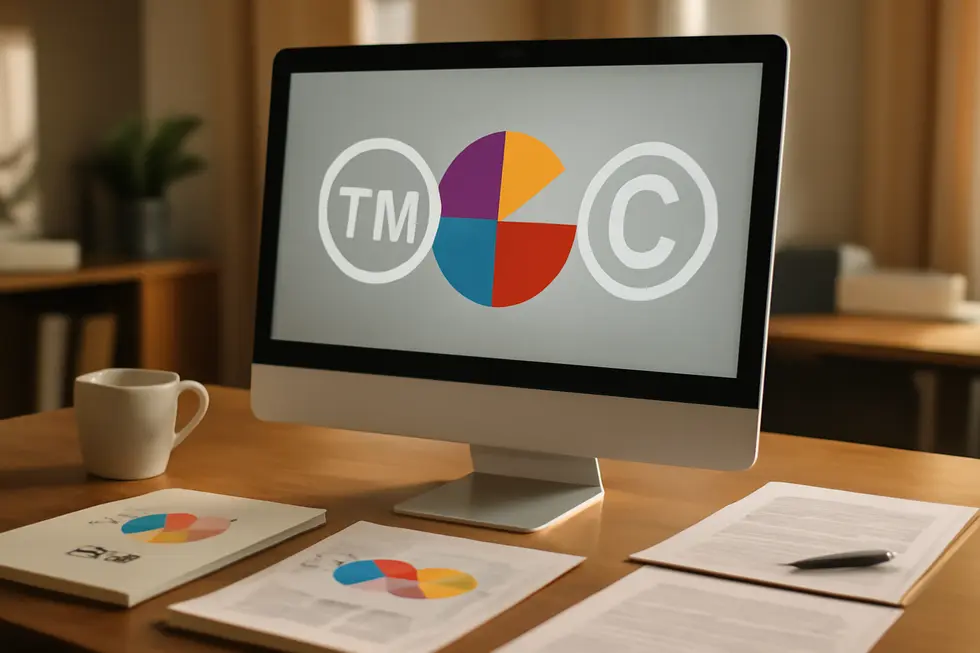Introduction
Logos are often the visual cornerstone of a business’s identity, making their protection crucial for every business owner. Understanding whether logos are copyrighted or trademarked is key to securing your brand’s creative assets and market position. Logos serve a dual role: they are artistic creations and symbols that distinguish your brand in commerce. This article unpacks both aspects of logo protection. First, you’ll gain clarity on the intertwined nature of copyright and trademark protections. Then, you’ll explore how trademark safeguards your logo’s role as a brand identifier in the marketplace. Finally, you’ll learn about copyright’s role in protecting the original artistic elements of your logo. Together, these insights will help you navigate comprehensive logo protection effectively.
Tables of Contents
Chapter 1: Understanding Are Logos Copyrighted or Trademarked: The Dual Protection Explained
- How Copyright Safeguards the Artistic Essence of Logo Designs
- Trademark Protection: Securing Logos as Powerful Brand Identifiers in Commerce
- How Copyright and Trademark Laws Work Together to Fully Protect Logos
Chapter 2: Trademark Aspects of Are Logos Copyrighted or Trademarked: Protecting Brand Identity in Commerce
- Creative Rights and Commercial Value: How Copyright Complements Trademark Protection for Logos
- How Trademark Registration Secures Your Logo’s Role as a Unique Brand Identifier
- Harnessing Dual Legal Protections: Strengthening Brand Identity Through Combined Copyright and Trademark Rights
Chapter 3: Copyright Elements of Are Logos Copyrighted or Trademarked: Safeguarding Original Artistic Design
- Trademark’s Role in Protecting Logos: Securing Brand Identity Beyond Artistic Design
- Protecting the Creative Essence: Copyright’s Role in Logo Design
- Harnessing Dual Protections: Seamlessly Integrating Copyright and Trademark to Fully Secure Logo Designs
Chapter 1: Understanding Are Logos Copyrighted or Trademarked: The Dual Protection Explained

1. How Copyright Safeguards the Artistic Essence of Logo Designs
Logos serve a dual purpose: as original artistic creations and as symbols representing a brand’s identity. Copyright protection fundamentally secures the artistic expression embodied in a logo’s design. From the moment a logo is created, its graphic elements—such as unique shapes, illustrations, and stylized images—are automatically shielded under copyright law. This protection prevents others from reproducing or copying the creative visual elements without permission, focusing on the originality of the artwork rather than its commercial function. Unlike trademarks, copyright does not require formal registration to take effect, offering immediate defense for the logo’s artistic features.
However, copyright’s scope is limited to the creative design itself and does not extend to how the logo functions in business contexts as a brand identifier. It protects the way the logo looks—not the way it is used in commerce. This distinction highlights why businesses often pursue trademark registration alongside copyright to comprehensively guard their logos’ multiple roles.
Effectively, copyright safeguards the visual artistry that makes a logo distinctive, ensuring that the original creative work cannot be copied freely. For entrepreneurs wishing to understand how to protect their logo artwork, it is crucial to maintain clear proof of originality and creation date. For a deeper dive into these distinctions and practical legal guidance, the article trademark your logo provides valuable insights.
More detailed information on these complementary protections can also be found here: https://carbonlg.com/copyright-vs-trademark-2025-protect-la-business/
2. Trademark Protection: Securing Logos as Powerful Brand Identifiers in Commerce
Trademark protection plays a vital role in securing a logo’s identity as a unique symbol representing a business’s goods or services in commerce. Unlike copyright, which guards the logo’s design as a creative work, trademark law focuses on preventing consumer confusion by prohibiting others from using logos that resemble a registered mark in a way that might mislead buyers. Securing a trademark involves either registering the logo with the U.S. Patent and Trademark Office (USPTO) or establishing legal rights through consistent commercial use. Registration offers significant advantages, including nationwide protection and the ability to enforce rights through federal courts. A trademark can cover the logo’s text, colors, shapes, or combination thereof, emphasizing its role in brand distinction rather than artistic originality. Importantly, trademark rights can be maintained indefinitely as long as the mark remains in use and all renewal requirements are met, providing enduring protection of the brand’s marketplace identity. For entrepreneurs, understanding trademark law’s emphasis on source identification is essential to protect their logo against imitation that could dilute their brand’s reputation or cause consumer confusion. To explore strategies for protecting your brand identity, see this guide on how to trademark your logo. For more details on trademark basics and registration, external legal resources such as Rocket Lawyer offer comprehensive insights.
3. How Copyright and Trademark Laws Work Together to Fully Protect Logos
Logos benefit from a layered defense through both copyright and trademark protections, each addressing distinct aspects of a logo’s value.
Copyright safeguards the original artistic elements of a logo automatically once it is fixed in a tangible form, such as a digital image or printed material. This protection focuses on the creative design itself, preventing others from replicating the exact expression of the logo’s artwork. Although registration is optional, it can enhance enforcement capabilities.
Conversely, trademark law protects the logo as a symbol representing the brand’s identity in commerce. By registering a logo with the U.S. Patent and Trademark Office, businesses secure rights to use the logo for specific goods or services, preventing others from adopting confusingly similar marks that could mislead consumers. Trademark protection requires actual use of the logo in commerce and is essential for defending brand reputation.
Together, copyright guards the logo’s artistic originality, while trademark defends its commercial significance as a brand identifier. This dual protection creates a comprehensive legal framework that addresses both the creative and commercial aspects of logos. Beyond these, companies can also use related protections like trade dress or non-traditional trademarks (such as distinctive colors or sounds) to further fortify their brand assets.
For businesses aiming for robust security, combining copyright and trademark protections is the most effective strategy. This approach ensures that a logo’s unique design and its role in brand recognition are both legally protected, minimizing risks of infringement and unauthorized use.
For detailed guidance on securing your logo’s brand rights, consider exploring resources on how to trademark your logo.
External reference: Carbon Law Group on Copyright vs Trademark
Chapter 2: Trademark Aspects of Are Logos Copyrighted or Trademarked: Protecting Brand Identity in Commerce

1. Creative Rights and Commercial Value: How Copyright Complements Trademark Protection for Logos
Logos embody both artistic creativity and commercial significance. While trademark law primarily safeguards logos as brand identifiers, copyright protection independently secures the logo’s original artistic design. Copyright arises automatically when a logo is created, offering protection against unauthorized copying of its unique graphic elements without requiring registration. However, this protection focuses solely on the logo as a creative work, not its use in commerce or its role in distinguishing one business from another.
Trademark protection, by contrast, targets the logo’s function in the marketplace—preventing others from using confusingly similar marks that might mislead consumers. Registering a logo as a trademark grants exclusive rights tied to specific goods or services and strengthens legal enforcement against counterfeit or infringing uses.
Businesses recognize that relying on a single form of protection leaves gaps; copyright safeguards the design integrity, while trademark secures commercial identity. Together, these protections provide a comprehensive shield, promoting both the creative expression behind a logo and its value as a trusted brand symbol. For companies seeking to register their logos fully, understanding and utilizing this dual protection approach enhances security and brand equity in commerce.
For more on securing brand assets, reviewing how to trademark your logo can provide valuable guidance. An insightful overview on the interplay between these protections is also offered by the Carbon Law Group.[3]
2. How Trademark Registration Secures Your Logo’s Role as a Unique Brand Identifier
Trademark registration grants exclusive rights to logos that uniquely identify a brand’s goods or services. Unlike copyright, which protects creative design elements, trademark safeguards logos as symbols that distinguish one business from another in the marketplace. This protection prevents others from using confusingly similar marks, helping to maintain consumer trust and brand reputation.
Successfully registering a logo involves thorough searching for existing marks and submitting detailed applications about the logo’s design and associated goods or services. Once approved, the trademark owner can enforce exclusive use rights through legal action, deterring infringement and preserving brand integrity. This exclusivity also enhances the logo’s commercial value, transforming it into an asset that supports marketing and business growth.
In an increasingly digital economy, trademark protection adapts to cover online and international use, ensuring logos remain secure across global markets and digital platforms. By legally establishing a logo as a trademark, businesses secure much-needed protection to prevent confusion, protect customers, and strengthen their market presence.
For businesses considering this vital step, understanding the trademark registration process and its benefits is crucial. More on how to formally protect your logo as a trademark can be found in this detailed guide on how to trademark your logo.
Source: Carbon Law Group on trademarking logos and brand identity
3. Harnessing Dual Legal Protections: Strengthening Brand Identity Through Combined Copyright and Trademark Rights
Employing a dual legal protection strategy for logos significantly enhances a brand’s ability to defend its identity in commerce. Logos qualify for both copyright and trademark protections, which serve complementary yet distinct purposes. Copyright safeguards the logo’s original artistic elements by protecting the creative expression fixed in a tangible form, automatically securing the design itself from unauthorized copying. However, copyright does not address the logo’s function as a brand identifier.
Trademark protection targets this commercial role by registering the logo as a distinctive symbol that identifies goods or services. This registration confers exclusive rights to use the logo in commerce and prevents others from using confusingly similar marks, thereby preserving brand recognition and consumer trust. While a trademark registration typically lasts ten years, it can be renewed indefinitely to maintain ongoing brand protection.
Combining these protections offers brands comprehensive legal coverage and broader enforcement options. A brand owner can challenge unauthorized logo reproduction via copyright infringement claims while also stopping marketplace confusion through trademark enforcement. This layered defense discourages misuse like plagiarism or trademark squatting and solidifies the logo’s role as both a creative work and a trusted commercial emblem.
For more detailed guidance on registering logos as trademarks, brands can explore resources such as trademark your logo.
Integrating copyright and trademark protections forms the backbone of a robust brand protection strategy, essential for maintaining clear, exclusive rights to both a logo’s design and its marketplace identity.[https://patentpc.com/blog/plagiarism-vs-copyright]
Chapter 3: Copyright Elements of Are Logos Copyrighted or Trademarked: Safeguarding Original Artistic Design

1. Trademark’s Role in Protecting Logos: Securing Brand Identity Beyond Artistic Design
While copyright safeguards a logo’s creative design, trademark protection plays the pivotal role in securing its commercial identity. A logo functions foremost as a brand identifier, distinguishing a company’s goods and services in the marketplace. Trademark rights ensure that competitors cannot use confusingly similar marks that might deceive consumers or dilute brand recognition. These rights can last indefinitely, provided the trademark is actively used and properly maintained, often enhanced by registration with the U.S. Patent and Trademark Office (USPTO).
Unlike copyright, which emerges automatically upon the logo’s creation to protect its original artwork, trademark safeguards the logo’s capacity to represent the brand itself. This includes protection of textual elements, color schemes, and specific design forms when registered. Businesses often pursue both copyright and trademark protection to comprehensively defend their logos: copyright to prevent unauthorized artistic copying, and trademark to prevent unauthorized commercial use.
This dual layer of protection strengthens a brand’s legal position, ensuring the logo’s appearance remains uniquely tied to its source in commerce. For a practical pathway to securing these rights, understanding how to formally register a logo trademark is essential and can be explored further through resources like this guide on trademarking your logo.
For a clear differentiation of trademark versus copyright roles regarding logos, Rocket Lawyer offers an insightful overview.
2. Protecting the Creative Essence: Copyright’s Role in Logo Design
Copyright protection serves to secure the original artistic expression embedded within a logo’s design. For a logo to qualify, it must display sufficient creativity and originality, surpassing mere basic shapes or simple text. This means that purely text-based logos or common geometric forms typically do not meet the threshold. When protected, copyright covers the logo’s graphic elements as an artistic work, preventing others from reproducing the creative design without permission. However, copyright does not stop others from using similar logos as brand identifiers in commerce; that is the domain of trademark law.
Copyright protection arises automatically upon creation of the logo in a tangible medium. This safeguard anchors ownership over the visual artistry, including unique illustrations, stylization, or complex design components. Businesses often reinforce their claims by embedding metadata or using copyright notices associated with their logo files.
Since logos function both as creative works and commercial symbols, copyright protection complements trademark registration, creating a robust defense. For a deeper understanding of formal protection routes, businesses can explore trademarking their logos, which helps secure brand identity alongside artistic rights.
More comprehensive legal distinctions and protections between copyright and trademark can be reviewed in resources such as Aaron Hall’s explanation of copyright vs. trademark.
3. Harnessing Dual Protections: Seamlessly Integrating Copyright and Trademark to Fully Secure Logo Designs
Logos benefit from two complementary legal protections that together secure both their creative and commercial value. Copyright automatically protects the original artistic aspects of a logo from the moment it is created and fixed in a tangible medium, such as its distinctive graphic design or illustration. This protection prevents unauthorized copying of the artistic expression but does not extend to how the logo is used in commerce. Trademark protection, by contrast, focuses on the logo’s role as a brand identifier, safeguarding its use in trade to prevent consumer confusion and protect brand reputation. This protection generally requires actual use or registration, guarding not only the logo’s text but also its unique design elements, colors, and style. By combining these protections, businesses create a robust legal shield that covers the logo’s artistic originality alongside its commercial identity. This layered strategy deters infringement both on the creative front—blocking direct replication—and in the marketplace, by stopping confusingly similar uses that could dilute the brand. Pursuing both copyright registration and trademark registration maximizes enforcement options and preserves the full value of logos in competitive markets. For more detailed guidance on trademarking logos, consider exploring resources on how to trademark your logo.
Final thoughts
Protecting your logo is essential because it embodies both your brand’s identity and your creative efforts. Logos are uniquely positioned to benefit from dual protection: trademarks secure your brand’s recognition and prevent confusing imitation in commerce, while copyrights safeguard the original artistic expression behind your design. Understanding these protections empowers business owners to take strategic steps ensuring comprehensive legal coverage. By pursuing trademark registration alongside recognizing copyright, you build a robust defense against misuse and infringement. This dual approach not only preserves your logo’s market value but also upholds your creative rights, reinforcing the strength and longevity of your brand.
Get your trademark today! Thousands have protected their brand by filing a trademark. What are you waiting for? Start your trademark application!
About us
The globe’s top website for registering trademarks and safeguarding your brand, name, logo, or slogan. We provide fast, reliable, and expert assistance to help business owners secure their intellectual property rights, ensuring their brands remain protected and uniquely theirs.






